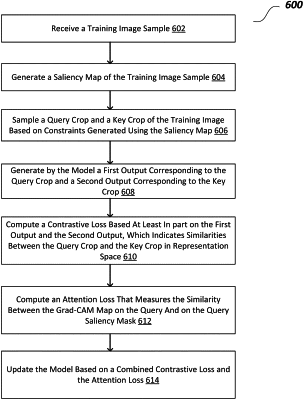| CPC G06F 18/2193 (2023.01) [G06F 17/16 (2013.01); G06F 18/214 (2023.01); G06N 3/045 (2023.01); G06N 3/084 (2013.01); G06N 3/10 (2013.01); G06T 7/194 (2017.01); G06V 10/25 (2022.01); G06V 10/462 (2022.01); G06T 2207/20084 (2013.01)] | 20 Claims |

|
1. A method for saliency-constrained random cropping of a training image, the method comprising:
receiving a training image sample for training a contrastive learning network;
generating, from the training image sample, a saliency map in a form of a binary mask indicating a plurality of salient regions in the training image sample;
generating a first random crop and a second random crop of the training image sample, both subject to a crop constraint that each of the first random crop and the second random crop overlaps with one or more salient regions in the saliency map for more than an area-overlap threshold;
sending the first random crop as a key and the second random crop as a query to the contrastive learning network;
computing a contrastive loss from the first random crop corresponding to the key and the second random crop corresponding to the query from the contrastive learning network; and
updating the contrastive learning network based at least in part on the contrastive loss.
|